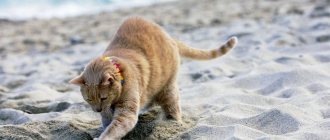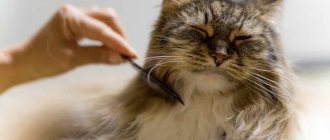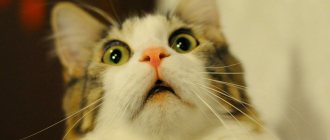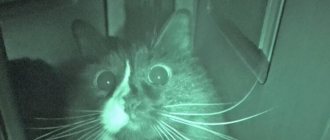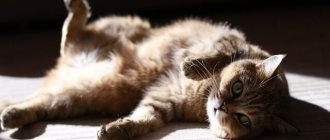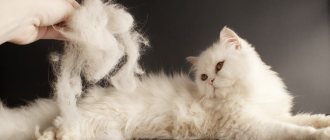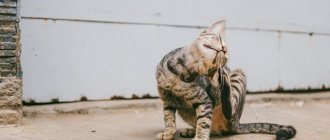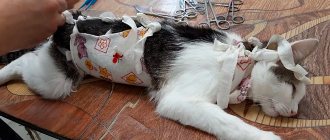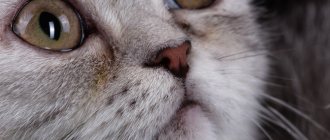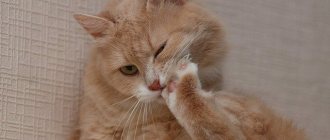Does the cat arch its back? Does she suddenly start running like crazy, as fast as she can, circling the room, jumping over couches or up and down the stairs, with her fur standing on end? It's very funny and interesting to watch, and at the same time scary, because she might bump into something and hurt herself. But she seems to be having a great time. Is it harmless fun or a cause for concern?
Most cats exhibit this behavior. Cat adventures, also known as periods of frantic random activity, are a normal and fun activity for them, although it can drive you crazy if they happen at 2 am.
When does a cat's fur stand on end and has a hunched back and why does the cat do this?
Deafness is often difficult to determine, especially because the cat may not report any hearing problems.
Usually the first signs an owner notices are the animal not obeying commands or not reacting to family noises. Compared to humans, cats have a completely different sound range. In humans it ranges from 20 Hz (bass sound) to 20 kHz (= 20,000 Hz, high sound). The cat, however, is capable of hearing sounds whose frequency ranges from approximately 48 Hz to 85 kHz.
Deafness can be hereditary in many breeds and may also be due to genetic predisposition. Cats with white fur and blue undertones are predisposed to deafness.
THERE IS NO SCARIEST BEAST THAN A CAT
...The fur on the black cat stood on end, and he meowed heartbreakingly. Then he curled up into a ball and, like a panther, swung straight at Bengalsky’s chest, and from there jumped to his head. Rumbling, the cat grabbed the entertainer's thin hair with its plump paws and, howling wildly, tore the head off his plump neck in two turns.
M. Bulgakov, “The Master and Margarita”
They say about the cat that it has the eyes of a psychic. But really, what kind of eye should a psychic have and what kind of gaze should he have if he “examines” the human biofield? And to what extent is the extrasensory perception of an animal related to its ability to cause harm to a person or, conversely, good?
American researcher Shafika Karagua believes that the gaze is very different from the usual one, it seems to come from within, from the center of the brain. A similar look can be noted in cats, especially when they look into space in a calm state, rather than watching a moving object; At this time, interest and mischief are read in the cat's eyes. Cats rarely blink, slowly rotate their eyeballs, all this gives their gaze calmness and grandeur. I am always surprised by the slit-shaped pupil in our domestic cats. This suggests that this is a nocturnal animal. Unlike small cats, a lion, which hunts during the day, has round pupils, like a human's. On a bright sunny day, a lion's pupil narrows so much that it reaches the size of a pinhead. Why then is a slit-shaped pupil necessary, which, by the way, can also be found in crocodiles, some vkula and other nocturnal animals? Most likely, this is an optical device to combat contrast. The lens of vertebrates is not a solid lens; it consists of fibers that meet at their ends at the anterior and posterior poles, forming so-called sutures. When the pupil is dilated, the illumination is low, most of the light rays pass through the lens, like through a regular lens, and produce an image on the retina. But in strong illumination, the contrast of the objects in question is so great that we should see as it does in photographs taken in the sun, when it is very difficult to see details in the shadows: they are almost black. A sharply constricted pupil causes most of the rays to fall into the suture of the lens. Light rays travel along the seam as if through a light guide. At the same time, they do not carry information about the image of the object in question, but, scattering at sharp bends of the lens fibers at the equator due to the cell nucleus present there, they cause a kind of illumination of the lens, smoothing out the sharp light contrast on the retina between dark and light areas of the image. This is especially necessary for a cat, because its eye is six times more sensitive than ours, and it must work equally well both day and night. This is why a slit pupil is needed - after all, most of the rays in this case fall into the seam. Behind the cat's retina there is a kind of mirror called terpetum. Some researchers call it "luminous wallpaper." Depending on the placement of the reflective crystals, the cat can either dim its eyes or flash them. It would seem that all this is known, but... the return path of light from the cat’s eye is focused, and if you put a screen on, you can clearly see the light spot. In such a spot, you can see a vague picture of what the cat sees at the moment, because all visual elements responsible for photochemical reactions (rods and cones) contain the visual pigment rhodopsin. In the dark, rhodopsin is colored purple, but as soon as a light beam falls on it, it becomes discolored. On the retina of the eye, the light pattern is not only projected, but also “outlined” by rhodopsin. In cats, the projected image, due to the presence of a “mirror,” will be even clearer than in humans and animals that do not have a reflective luminous layer behind the retina. It is difficult to ask a cat how it uses its ability to project images from its eye, but there is something similar in humans. Psychiatrist from Perm Gennady Krokhalev managed to photograph visual hallucinations of patients. Consequently, even a person’s eye works “in the opposite direction,” so what can we say about a cat armed with a special projector. Now the time has come to talk about extrasensory proscopic rehearsal, that is, about the mental playback of the upcoming event. Such rehearsals are carried out not only by cats, but also by plants, animals and people. In caves left by ancient people, we now find rock paintings depicting hunts for buffalo, bison and mammoths. Why did they draw all this? Perhaps they had a chronicler who wanted to leave a diary of their lives for posterity? Historians and ethnographers believe that this is not so. When getting ready to hunt, ancient people would first play it out in their minds and “reinforce” it with a kind of dance. Something similar happens when fighting dances are performed by Indians or hunters of African tribes, even in our time. A civilized person uses such predictive rehearsal less and less; sometimes only an athlete, for example, before pushing a barbell, mentally plays out this action several times. Now let's return to our cat. She also needs to create a spatial program for future actions both before the hunt and before the jump. It is not at all necessary to conduct any special research - just watch your cat, and you will see that before jumping from one cabinet to another, standing in the distance, she will bend down and mentally “replay” this jump several times. In its games with various objects, the cat constantly creates spatial images for itself to hunt mice. She doesn’t need drawings, sculptures, or voltaic dolls at all: she actually sees her hallucinations during a game or before a difficult jump. But just don’t think your cat is crazy, she controls the projected images, unlike a truly crazy person who also really sees hallucinations, but cannot control them. True, there are also people who in this respect are similar to cats, for example, Goethe, as they say, could control his hallucinations: at the right moment he called his double and discussed with him what actions Faust should perform in the next chapter of the work he was creating.
Well, now a little in defense of cats, let it be an assumption, but based on real biological facts. Will a small animal be able to protect itself from those who throw stones at them, chase them or begin to torture them? Probably he can, because it is enough for a cat to mentally project the tormentor in space and imagine what she would do with him if she were the same size as a person... She will fulfill the same mission that the sorcerers of Australia or African sorcerers perform, according to some sources they are capable of even thinking in images, kill a person. Of course, the cat's pursuer will not die from this, but an information image will be created that harms exactly the person for whom it is intended. For those who love cats, apparently only positive images will be created. Some cat owners claim that Barsik or Murka are even trying to treat them. They lie down on the sore spot, as if sympathizing with the owner, and the pain subsides. Therefore, cats behave in the same way as psychics. Is this possible? Firstly, in this case the cat acts as a kind of heating pad, secondly, in addition to heat, its fur carries electrostatic charges and, finally, it can form positive images that contribute to the correction of the biofields of the diseased organ, which, in turn, force changes in biochemistry the affected organ and its functioning. Of course, these are only assumptions, but based on real practical results.
Cats are not indifferent to people and even try to help their owners, but again, rather informationally. For example, my Siamese cat Murchik, who, by the way, lived with us for 19 years, helped me put my son to bed when he was 4-5 years old. He would come, sit down near the bed, closer to the head of the bed, and sit there motionless, sometimes purring, until the child fell asleep. You could be with him, you could leave him alone, but Murchik never left his post and left only when the boy completely fell asleep. We have only just touched upon the mysterious psychic world of cats, but many more interesting discoveries await us in this little-studied area.
Let's give the floor to Olga Saranina, who had trouble with her beloved cat.
“Cats are not so much mystical animals as they are little-studied. These aloof creatures, who seem to only allow us to live with them, can be gentle friends, but they can also pose a threat.
There are cases when cats, for no apparent reason, rushed at their owners, so much so that the matter ended with the intervention of doctors. One day, a similar madness engulfed my cat.
I have never had a smarter cat than Kitty. We understood each other perfectly, she slept under my blanket, and after the shower she licked my hair. Her mother was brought from Egypt, where she was picked up on the street by a friend of mine. Kitty, having a real “Egyptian” mother, met local Vaska at the dacha when she grew up, and three tri-colored - happy - kittens were born. The fastest one in this “international” litter was my Kitty.
She behaved like a dog: when she met us, she would lie down with her belly up and let us scratch it, squinting her eyes. Everything was great until one day Kitty threw herself at me. Before my eyes, my beloved cat turned into an aggressive predator, who, baring his teeth, screaming and hissing terribly, rushed at me and climbed me like up a tree.
Everything was like in a horror movie. I didn’t immediately decide to tear her away from me: this would mean that her claws, embedded in my skin, would tear out pieces of “meat”. I remember the moment when fear overpowered the pain, and I stopped feeling the pain itself - I had to get rid of this strong, dexterous and ruthless beast. I managed to throw the cat out the door and locked myself in the room. For about ten minutes Kitty screamed in a voice that was not her own, and then the flash seemed to pass: she began to timidly and insinuatingly meow to be allowed in. I didn’t dare open the door for an hour. When Kitty finally entered, she behaved uncertainly: she looked around, sniffed, and walked on half-bent legs. She seemed to remember that something had happened here, but she couldn’t remember what it was.
She was one and a half years old then. This happened again six months later, and in increasing order: she attacked me on Monday, then on Thursday, and on Friday twice in a row, after serving an hour in lockup. It was terrible. After these two attacks in one evening, we called the vet the next morning (the cat, of course, spent the entire time in a closed room). When the doctor arrived, he said that maybe everything would work out. When he saw Kitty, it turned out that nothing could be done: her pupils were dilated and did not shrink from the bright sunlight. “The center of aggression is overexcited. She is dangerous,” he said. Soon Kitty passed away.
Now I understand how careless it was on our part not to do anything after the first attack. Then veterinarians told me about terrible cases when cats clawed out their owners’ eyes, threw themselves on their heads from the closet, and so on.
So what is it, why are cats aggressive towards their owners? With this question, I turned to two famous doctors - Vladimir Nikiforovich Mitin, the author of books on diseases of domestic animals, and Nikolai Valentinovich Loginov, the head of the veterinary clinic at the Yuri Kuklachev Cat Theater, a member of the presidium of the Moscow Guild of Veterinarians.”
V.N. MITIN: Cases of aggression are possible for various reasons, and it is not always possible to say what exactly happened. This may be a consequence of mental disorders. In addition, it is necessary to take into account the psychological moment: who does the cat consider to be the main thing - itself or the owner. In cases of attack, it is usually advised to change the owner or euthanize the animal. This kind of aggression is more common in cats than in cats because the cat is a creature with more complex behavior. Is it possible to predict such an outbreak? Again, it depends on what we're talking about. There is a brain disease in which positive emotions cause outbursts of anger. Deviations in animal behavior can be either congenital or acquired. It is difficult to say in general what happened in this or that case; each one must be seriously analyzed.
As for whether outbursts of aggression are more common in purebred cats or mixed breeds, this is individual, there is no pattern. There is, however, one rule: short-haired breeds are more aggressive.
N.V. LOGINOV: I believe that this is due to sexual deviations. Some individuals produce more sex hormones, and if the animal is not mated, outbursts of aggression are possible. It is typical that in such cases cats attack women, and cats attack men, seeing them as competitors.
There is only one way out in these cases: sterilize the animal. When the production of hormones stops, outbreaks of sexual aggression go away on their own, and the behavior of animals changes. This operation can be performed at any age, if we are talking about such a serious case. The same applies to dogs. And in general, if you are not going to breed your cat, then it is more humane to immediately sterilize the animal, this is customary all over the world. It's time for us to become civilized on this issue.
We must also keep in mind that cats are very sensitive to the mood of their owner and, by the way, cannot stand the smell of alcohol. Therefore, it is quite possible that a cat will become aggressive if a tipsy owner comes up to kiss her. And one more very simple safety measure - trim the nails of aggressive animals.
There is only one conclusion from all that has been said: if you decide to get an animal, be responsible for it. Talk to experts, read literature, study the behavioral characteristics of cats. If you are about to deprive your pet of the joy of procreation, then do not delay - sterilize him. Without waiting for lacerations on the face and the premature violent death of an ancient, inviolable animal - our cat.
We will also talk about the extrasensory perception of animals. About the mysticism of “black cats”, about the benefits and harm.
How can I tell if my cat is deaf?
As we mentioned at the beginning of the article, it is difficult to determine deafness in cats, especially if it is only one ear or partial deafness. Since pets cannot communicate that they cannot hear, the best test for confirming the presence or absence of deafness is to observe the cat's reaction to sounds (the animal must be consciously aware of the sound).
For example, try different types of noises and from different objects (starting with soft noises, gradually increasing the intensity) and observe how the cat reacts (or not) to them. Often cats will make an involuntary movement of their ears (known as the "Pryor reflex") in response to sound.
If you suspect your cat may have a hearing problem, consult with your veterinarian to determine the type of deafness and how to intervene.
Symptoms
In a cat, the process that leads to deafness usually occurs gradually. Cats have the ability to easily rely on other senses to compensate for any specific sensory deficits, and it is likely that an owner will not be able to realize that the animal is deaf until it has lost most of its hearing ability.
A cat that becomes deaf has subtle signs. For this reason, many owners tend to wonder if the animal has decided to ignore it completely. For example, if previously it was enough to call the cat verbally, shake a package of crunchy crackers or open a can of meat for it to jump out after a few minutes, now you need to look for it to show that food is in the bowl, this can be a revealing sign. Other examples might be a cat's fearful reaction when you pet it and it is relaxed, or the cat's unresponsiveness to a common call such as “Come here!”
If your cat appears to be losing hearing, make an appointment with your veterinarian. Hearing loss is generally not a serious condition, but it is advisable to ensure that there are no underlying conditions that may be contributing to the problem.
It expresses fear
If the hair on your cat's tail and back is standing up, be careful. This is a sign of defensive aggression called piloerection. The theory is that the animal is trying to look bigger than it is and scare the enemy. In this case, it might be you.
Please note that classic “Halloween cats” are always depicted with raised fur.
The bottom line is that piloerection is the result of fear, not overt aggression. Every time I see this behavior, I calm down, slow down my movements and do everything in my power to relax and calm her down, to show her that I mean no harm.
Influence of nutrition
Feeding the same food for a long time leads to greasy hair in cats.
Cheap store-bought food contains a large amount of vegetable protein, but has very few vitamins and microelements. This leads to a deterioration in the condition of the cat's fur and overall health.
You should choose high-quality and complete food for your animal.
Homemade food should also be balanced. The pet cannot eat leftovers from the owner's table.
Chicken meat, offal, cottage cheese, cereals, and unsweetened fruits should be given. Meat products should not be subjected to heat treatment.
Types of deafness
There are two types of deafness in cats: conductive or sensorineural.
Conductive deafness
When sounds cannot travel properly through the outer ear or middle ear, the problem is called a conduction problem. This can happen if there is an ear infection, a ruptured eardrum, occlusion of the ear ducts, or fluid inside the ear. Typically, these patients have only partial hearing loss, and treatment involves medical or surgical correction.
Sensorineural deafness
When sensorineural deafness is present, the inner ear is involved and the deafness is usually complete. Sensorineural deafness often occurs due to neural problems or problems with the fluid dynamics or physical properties of the inner ear. Deafness is quite common in pets as they age, and sensorineural deafness may be the cause.
Danger of tangles
For a cat, the appearance of mats causes not only discomfort. Dense lumps pull on healthy hairs that accidentally get there. When moving, the cat feels pain. Sometimes quite strong. Trying to get rid of lumps, he may even injure himself with his claws or teeth. Such wounds then heal for a very long time. Other dangers of hairballs :
This may be further associated with pain and fear. Then the cat will begin to resist if the owner tries to remove the matted hairballs. If you don’t get rid of tangles, then every day there will be more and more of them. As a result, strong moisture will begin to accumulate under the fur, and this is fraught with the appearance of ulcers and inflammation.
Causes of tail wagging
Why do cats bury food - next to the bowl and what does this mean?
Cat owners will certainly name communication as the first reason why cats wag their tail. And not so much with their own kind (although this is the main direction of their communication), but with their owners.
This is partly true: with its movements, the cat signals its psycho-emotional state and informs about its intentions. However, yard cats, which often lose their tails in fights, as well as breeds without them, for example, the Kurilian Bobtail, do not experience problems in communication and socialization. They resort to other means: whiskers, ears, meowing, body language. Therefore, to say that the tail serves only for communication is not entirely accurate.
Very often in hot weather you can observe the following picture: a cat wags its tail and what this means is not entirely clear. The explanation for this behavior of cats is simple: in this way they escape from the heat, using a fluffy limb as a kind of fan or fan.
They also use it in cool weather, hiding their paws and muzzle under their tail - this way they protect them from the cold.
Representatives of the cat family tend to wander around the surrounding area, choosing the most unusual routes for this. Fences, roofs, trees - nothing escapes their attention. They are able to walk where common sense would not, making them envious of their acrobatic abilities and sense of balance. Scientists are inclined to explain this by the presence of an additional limb - it helps them balance. But then again, cats lacking a tail (whether from birth or injury) are capable of the same mind-boggling feats.
The dexterity of cats is associated, first of all, with the structural features of the joints to which the legs are attached.
This judgment also applies to the most famous fact about cats: they always land on four paws. Experiments were conducted in which tailless cats fell backwards from a height of about 2 meters. The absence of a tail did not at all affect their capabilities, and they regularly turned over in the air during flight.
Another explanation for why cats wave their tail is that they use it as a rudder. This is especially noticeable when observing the cheetah - the owner of a fluffy and long tail in proportion to the size of the body. At the moment when he makes a sharp turn to the right, the tail deviates in the opposite direction.
This is interesting! It happens that a small kitten plays with its tail. This is like a cheap substitute for a toy when there is no other entertainment for the cat on the horizon.
The anatomy of this limb is such that it is essentially a continuation of the spine. Mobility is associated with a jelly-like substance contained between the vertebrae. The tail contains nerve endings responsible for the genitourinary system and control of the hind legs.
To summarize, we can say that cats need their tail for communication and hunting, as a means of regulating body temperature. However, its absence will not at all affect the cat’s abilities, and she will quickly learn to do without him.
Cheetah while running
Tail wagging
There are several reasons why cats wag their tail. The first is a greeting, characterized by slight movements back and forth. The cat shows that she feels comfortable, she is happy. She will then rub her head against you. The cat may also wrap its tail around your leg or arm. This is her way of showing that she loves you.
Slowly waving from side to side shows that the cat wants to play. Some even twitch their tail just while lying on the floor. Following this, the cat may try to grab you with its paw. They often wag their tail when playing with toys or feathers.
Sometimes cats wag their tail when they are very concentrated. Such short, quick twitches can be seen when animals are intensely looking out the window. Perhaps they watch the birds so diligently that they imitate the behavior of predators.
But if the cat raises its tail strongly to its back, and then sharply lowers it, retreat. An attack will follow, you have been warned.
Cosmetics against dull fur
Grooming, which includes brushing, massage, trimming, removing tangles and bathing, is of no small importance. During the procedures, dead undercoat and weak hairs are removed, the skin is massaged, which stimulates blood flow to the upper layers of the epidermis. Properly selected shampoos, conditioners and nourishing masks will help restore abundant hair growth and its structure, and ensure skin hydration and regeneration. The cosmetic treatment for a cat's fur includes the following steps:
Arthritis
It is estimated that about 90 percent of cats over 12 years of age have radiographic evidence of arthritis. These are kitties with potentially stiff, inflamed joints!
A stiff elbow or shoulder prevents the animal from using the paw-style “face cloth” for cleaning. But more than that, an arthritic neck or spine makes it difficult for them to turn around to straighten themselves out.
Have you ever noticed how older cats tend to have mats on their sides and buttocks? This is due to arthritis in the spine.
However, there is a licensed medication that can be prescribed by your veterinarian to help relieve the discomfort of arthritis and improve your pet's overall quality of life. Plus, brushing them once a day reduces their workload, so they have a better chance of staying clean and beautiful.
catalogue of articles
Symptoms Possible causes Actions to be taken
Weight loss: fever, cough, nasal discharge, difficulty breathing, ruffled hair. Tuberculosis Consult a veterinarian
Lack of appetite: no other symptoms Monotonous diet Change diet
- vomiting, difficulty swallowing, lethargy Qatar Consult a veterinarian
- vomiting, diarrhea, prolonged urination; Mental disorders (often due to lack of attention) Find out and eliminate the cause
- fever, cough, discharge from the eyes, urinary incontinence (with hard stool); Pneumonia Consult a veterinarian
- high fever, severe diarrhea (often vomiting); tousled coat, lethargy Pneumonia See a doctor immediately
Difficulty breathing: - with attacks of suffocation during shortness of breath and dry cough; Asthma Consult a veterinarian
- rapid breathing. high fever, painful cough; Pneumonia Consult a veterinarian
- bad breath with prolonged vomiting and diarrhea; Uremia Consult a veterinarian
- fever, sneezing, dry cough, nasal discharge; Tuberculosis of the chest cavity Consult a veterinarian
- shortness of breath with convulsions, drooling, tactile sensitivity; Poisoning Consult a veterinarian
- if there is a change in behavior: agitation or apathy, aggressiveness - difficulty swallowing, severe drooling Rabies See a doctor immediately
Cough: - grunting - also with vomiting, lethargy, lack of appetite and fever, rapid breathing, pain; Respiratory disease (catarrh) Consult a doctor
- dry, with fever, nasal discharge, shortness of breath, emaciation; Tuberculosis Contact your veterinarian
— with fever, discharge from the nose, eyes, lack of appetite Feline pneumonia Contact your veterinarian
Runny nose: - with difficulty swallowing during fever Cat runny nose Contact your veterinarian
Wheezing: - when coughing with sputum, fever; nasal discharge; emaciation; Tuberculosis Contact your veterinarian
Discharge: - from the nose with fever, cough, phlegm, emaciation; Tuberculosis Contact your veterinarian
- from the nose and eyes with fever, cough, lack of appetite; Feline pneumonia Contact your veterinarian
— from the vagina at different body temperatures Suppuration of the uterus Contact a veterinarian
Sputum: - with fever, cough, difficulty breathing (wheezing in the lungs), nasal discharge, emaciation; Tuberculosis Contact your veterinarian
- with high fever, diarrhea (often vomiting); tousled fur, lethargy Feline distemper See a doctor immediately
Sore eyes: - sticky eyelids, purulent discharge in the corners of the eyes; Conjunctivitis Treat with boric acid solution or eye ointment (boric petrolatum)
- discharge from the eyes and nose; fever, cough, lack of appetite Feline pneumonia Contact your veterinarian
Thirst: - with frequent urination, lethargy, stiff gait; Chronic inflammation of the kidneys Follow a diet, give plenty of fluids, decoctions, milk
- with vomiting, diarrhea or constipation, bloated abdomen, weakness Gastrointestinal disorders Contact your veterinarian
Vomiting:—without other symptoms (especially after eating grass); Swallowing a foreign object, too large a piece of meat, or a hairball; too cold food goes away on its own. Serve food at room temperature rather than straight from the refrigerator
— after greedily eating food (especially in the company of other cats);
Feed separately from other cats: 3-5 times a day in small portions
- with diarrhea, lack of appetite with unusual urinary incontinence; Mental disorder (usually due to lack of contact) Find out and eliminate the causes, pay more attention
- choking when eating with grunting, lack of appetite, lethargy; Qatar Contact your veterinarian
- with constipation or diarrhea, cramps, bloated stomach; thirst, weakness, emaciation; Gastrointestinal disorders Contact your veterinarian
- with diarrhea, bloated belly, dull coat; sometimes with convulsions; Worm infestation Contact your veterinarian
- bloody with bloody diarrhea; Severe poisoning (rat poison) Contact a veterinarian immediately
- repeated, with diarrhea, bad breath, ulcers on the oral mucosa, lethargy; Uremia Contact your veterinarian
— with foam (color: green to yellow) Feline distemper Contact your veterinarian immediately
Diarrhea:—without other special symptoms; Diet-related digestive disorders (due to excess milk, raw liver, spleen, brain; due to old food) Reduce portions. Give black tea (diluted), boiled liver
- together with urinary incontinence and changed behavior; sometimes also vomiting and lack of appetite; Mental disorders due to insufficient attention (or preference given to another pet) Identify and eliminate the causes
- constantly watery; Various reasons Consult a veterinarian
- with vomiting, bad breath, ulcers on the oral mucosa, lethargy; Uremia Contact your veterinarian
- with vomiting, thirst, pain sensitivity, weakness, emaciation; Gastrointestinal disorders Contact your veterinarian
- with dull fur and a bloated belly, convulsions are possible; Infection with worms (roundworms) Follow a milk diet, fasting day
- bloody, mostly with bloody vomiting Severe poisoning (rat poison) Contact a veterinarian immediately
- with intense fever; disheveled fur, frequent vomiting; lack of appetite, lethargy Feline distemper Contact your veterinarian immediately
Problem teeth
An estimated 85 percent of cats aged 3 years and older that have dental disease have difficulty washing themselves daily.
Diseases can take different forms:
When a cat's main means of grooming is its mouth, if its teeth hurt, they stop washing themselves altogether.
The only solution here is to deal with these dental problems - after all, you wouldn't want to live with a nagging toothache, so why should a cat?
Strange cat behavior
The pet owner should be wary if the cat begins to rush around the apartment and meow barely audibly. At the same time, if her fur stands on end and her ears flatten, as if she sees something very scary, then you should understand that things are bad.
A type of “dangerous” behavior of a pet may not be activity and rushing around the apartment, but a complete numbness of its body. However, all other habits will be the same, and the general picture of the pet’s excited behavior will be very alarming - they often try to take all measures to get out of the home, asking to go outside.
The cat's hair is falling out: features of shedding in modern pets
Molting is common to all living things, even insects molt. And this process also does not bypass the cat. However, shedding in cats that constantly live in an apartment is special. Let us explain why.
Cats living in their natural environment shed twice a year - in spring and autumn. The processes of hair loss and regrowth are regulated in their body by the changing seasons. Pets who constantly live in an apartment lose their biorhythms that regulate the molting process. Their bodies are affected by central heating, their metabolism is disrupted by stress, poor diet, and lack of physical activity.
That is why for a cat living in a city apartment, it is important to talk about constant shedding, which does not stop throughout the year, and intensifies during the off-season.
Source
Preventing the appearance of mats in cats
It is easier to prevent tangles from appearing than to untangle and comb them out later. To do this, it is important to follow the following rules.
Health monitoring
It is recommended to regularly examine the cat at home, for example while brushing or playing, and to have a medical examination with a veterinarian 1–2 times a year. At the first signs of illness or the presence of alarming symptoms, the animal should be taken to the veterinarian as soon as possible.
Balanced diet
Careful proper care
For daily combing of fluffy cats, you will need combs with sparse, non-sharp teeth and special brushes. It is better to carry out the procedure in several stages so as not to cause fatigue and irritation to the animal. When combing, special attention is paid to the armpits, belly, tail, and areas behind the ears. It is necessary to accustom a cat to such manipulations from an early age. In addition, daily brushing helps not only maintain the aesthetic appearance of the coat, but also strengthens the emotional connection between the owner and the cat, allowing you to show your pet your love and care.
Source
